Enhancing Your Kitchen with Small Pendant Lights
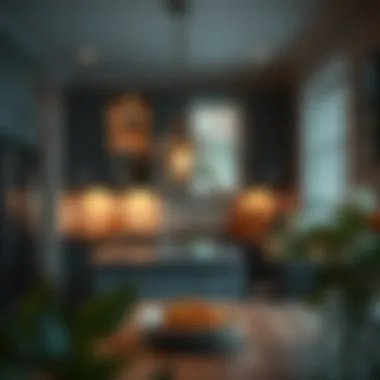

Intro
In today’s world, where kitchens are not just places to cook but also spaces for socializing and creativity, small kitchen pendant lights have carved out a niche of importance. These fixtures not only provide light but can also add flair to a compact space, transforming it into a haven of style and functionality. The thoughtful inclusion of pendant lights can elevate the overall ambiance of a kitchen, turning everyday chores into a delightful experience.
Opting for the right small pendant light can weave together the aesthetics and practical needs of your kitchen. They come in a range of styles, shapes, and finishes, each playing a role in complementing your culinary haven. As we unearth different trends and styles in lighting, it will become clear how these small yet impactful elements can redefine kitchen spaces. This guide aims to offer insights and practical advice, aiding homeowners and design enthusiasts alike in making decisions that resonate with their personal style and functional requirements.
Furniture Styles and Trends
Modern vs. Traditional: Understanding the Aesthetics
When selecting pendant lights, it’s crucial to understand how they fit into your kitchen's overall design ethos. The dichotomy of modern and traditional styles presents a spectrum of choices that can make or break the decor of a small space.
Modern pendant lights are typically characterized by their clean lines and minimalist designs. Think sleek metal finishes or clear glass shades that allow light to cascade freely. These fixtures can often double as pieces of art, showcasing a sort of understated elegance that seamlessly fits into contemporary kitchens.
On the flip side, traditional pendant lights may incorporate ornate designs, intricate detailing, and warm finishes like bronze or aged brass. They resonate with homes that showcase a more classic or rustic decor style, evoking warmth and nostalgia. For example, a vintage-inspired pendant can become a fantastic focal point over a small kitchen island, bridging the gap between function and heritage.
"The right light can highlight the beauty of your kitchen's style, weaving a golden thread through the fabric of your home’s personality."
Color and Material Trends: What's In and What's Out
The choice of color and material can significantly influence the effectiveness of small kitchen pendant lights. Currently, muted tones such as matte black, soft gold, and brushed brass are making a statement. These colors provide versatility, blending well with a variety of kitchen styles while offering a modern twist. A richly colored pendant made of glass or ceramic can add character to an otherwise understated space.
Material selection also prompts specific responses within the kitchen environment. Industrial materials like concrete or metal are gaining traction for their rugged charm, often associated with urban aesthetics. Meanwhile, ceramics or natural fibers denote an organic, inviting atmosphere, perfect for smaller, intimate areas.
In terms of trends, we continue to see a shift towards sustainability. Eco-friendly materials are being favored, with many designers opting for recycled glass or sustainably-sourced woods. This not only caters to aesthetic preferences but speaks to a growing consciousness about environmental impact.
Installation Tips and Best Practices
Integrating pendant lights into a smaller kitchen involves more than just selecting the right style and material. It requires a keen eye for layout and practical installation. Here are some quick tips:
- Height Matters: Install the pendants about 28 to 34 inches above the countertop or island to optimize functionality without obstructing sightlines.
- Spacing is Key: If using multiple pendants, be sure to space them evenly to maintain visual balance. Generally, three feet apart works well in most layouts.
- Dimming Capability: Consider fixtures with dimming capabilities. This feature allows flexibility in mood setting, from bright task lighting to softer, ambient light for cozy dinners.
- Use of Complementary Styles: Ensure that the lights match or complement other fixtures in the space. This could include cabinet hardware or appliances to maintain a cohesive look.
By understanding the interplay between aesthetics and installation, one is better equipped to select and install small kitchen pendant lights that truly enhance the space.
Culmination
Choosing small kitchen pendant lights can be both an art and a science. Taking into account style, color, material, and placement will yield a visually appealing and functional kitchen space. Homeowners and designers alike have the opportunity to create an engaging kitchen atmosphere that delights daily, redefining what it means to cook and gather in one of the most cherished spaces in the home.
Prelims to Small Kitchen Pendant Lights
In contemporary kitchen design, small kitchen pendant lights stand out as pivotal elements that marry both aesthetics and functionality. These fixtures don’t just illuminate; they accentuate. They serve as focal points, adding character and depth to often overlooked spaces. Whether you have a snug galley layout or an open-plan area, incorporating pendant lights can transform the way you perceive, operate, and enjoy your culinary space.
From blending in with various decor styles to enhancing task areas, these lights bring benefits that go beyond mere illumination. For instance, when placed strategically, they can create a warm, inviting atmosphere perfect for family gatherings or intimate dinner parties. This is especially important in a kitchen—often considered the heart of the home—where ambiance plays a significant role in the overall experience of cooking and dining.
When it comes to selecting small kitchen pendant lights, a few important factors come into play. First, the scale is crucial—these fixtures should complement the size of the room without overwhelming the space. Second, the design style needs to harmonize with your chosen decor, whether that's modern, rustic, or somewhere in-between. Lastly, functionality cannot be ignored; the right pendant lights can enhance visibility in key prep areas, making tasks like chopping vegetables or measuring ingredients easier and safer.
Taking the time to understand the importance of these lighting choices can lead to better decisions and ultimately a more cohesive design. It’s about striking that much-needed balance between style and practicality. Indeed, small kitchen pendant lights are not just decorative ornaments; they are essential components that play a significant role in creating a space that is both beautiful and functional.
"Lighting is a way to bring art into a kitchen; it's not just about visibility, it's about creating a mood that enhances not just the space but the cooking itself."
As we delve deeper into the nuances of small kitchen pendant lights, you'll discover how different styles, materials, and placement strategies can be harnessed to elevate your kitchen experience.
Understanding the Importance of Kitchen Lighting
Lighting plays an integral role in the kitchen, serving as both a practical requirement and an opportunity for aesthetic enhancement. Understanding this dual influence of kitchen lighting is crucial for homeowners and designers alike. Small kitchen pendant lights, in particular, can significantly contribute to the atmosphere and overall functionality of the space. They can create a welcoming environment while ensuring sufficient illumination for tasks.
One of the first benefits of well-designed kitchen lighting is creating an ambiance that complements the style of the kitchen. Warm, soft light can transform a stark, clinical cooking area into a cozy nook where family and friends gather. This type of atmosphere is particularly vital in small kitchens, where space is limited, and creating a sense of openness and warmth is paramount. The right pendant light can act as a unifying element, marrying different design aspects together.
In practical terms, effective kitchen lighting enables several critical daily activities. Cooking requires focused lighting to prevent accidents and ensure that meal preparation is efficient. The brightness and position of pendant lights should facilitate visibility over countertops and stovetops. If a light source is too dim, it could lead to mishaps, especially with sharp knives or hot surfaces. Beyond aesthetics, proper illumination enhances safety.
The placement of these lights matters significantly as well. Supplementing overhead pendant lights with under-cabinet lighting can create a layered effect, offering both style and clarity. This approach balances functional needs with design considerations.
"Good lighting is not just about visibility; it’s about creating the mood and function of a space."
In addition, energy efficiency is a contemporary concern. Energy-efficient lighting options, like LED bulbs in pendant fixtures, provide substantial savings on electricity bills and last longer than traditional bulbs. Opting for sustainable lighting not only benefits the household economically but also aligns with eco-friendly practices that many modern homeowners appreciate.
Thus, recognizing the importance of kitchen lighting—especially through the use of small pendant lights—emphasizes the need to think beyond mere functionality. Creating ambiance and ensuring safety while also focusing on energy efficiency can transform not just the kitchen but the everyday routines surrounding meal preparation and family interaction in this vital space.
Exploring the Various Styles of Pendant Lights
When selecting small kitchen pendant lights, understanding the diverse styles available is crucial. Styles can drastically influence the overall feel of your kitchen, turning it from simply functional into a space that reflects personal taste and provides a warm atmosphere. Choosing the right style means considering factors such as the kitchen's existing decor, the natural light that flows, and even the emotional response you want to evoke when you enter the space.
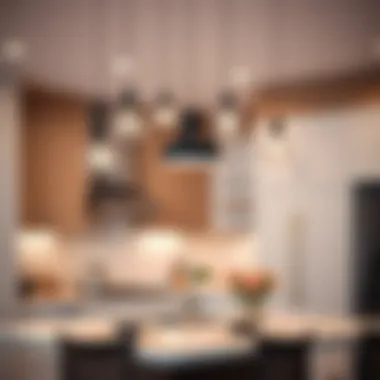
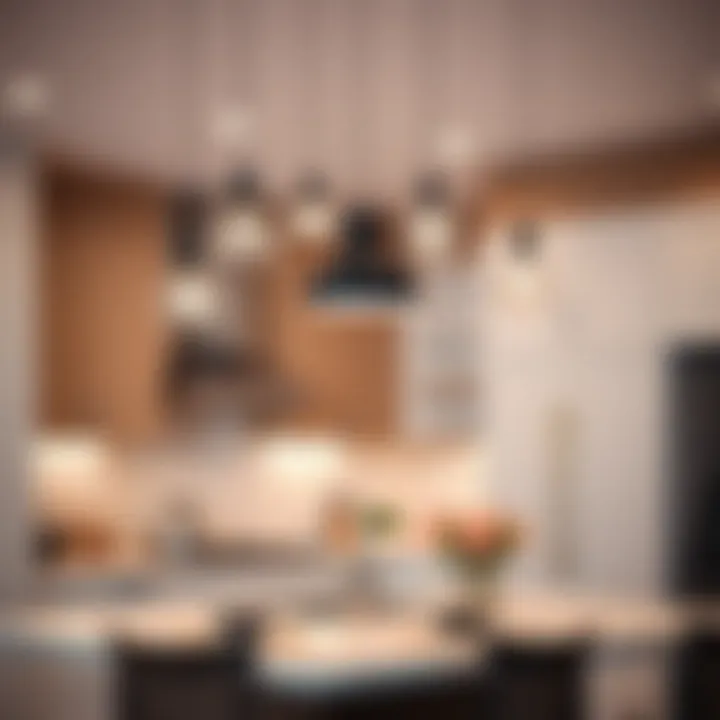
Modern Designs for Contemporary Kitchens
Modern pendant lights have a clean and linear look that often incorporates geometric shapes. These designs are typically crafted from materials like metal and glass, reflecting a sleek, polished aesthetic that complements contemporary kitchens beautifully.
The benefit of using modern designs is their versatility. They can fit within various color palettes and might even serve as eye-catching focal points without overwhelming the space. LED options are widely available and can generate ample light without consuming excessive energy.
Incorporating a modern pendant light, such as the popular Tom Dixon Beat Light, can elevate the kitchen's ambiance. These units often feature minimalist silhouettes that enable them to blend in or stand out, depending on how you want to integrate them into your kitchen design.
Vintage and Rustic Options
On the flip side, vintage and rustic pendant lights bring character and warmth to a space. These fixtures might include wrought iron, aged metals, or even reclaimed wood. They exude an inviting charm, often associated with farmhouses or coastal cottages.
Choosing vintage styles like the Barn Light Electric Gooseneck Pendant can make a profound statement. They hark back to simpler times yet can be very much at home in modern kitchens. The warm glows offered by antique-style bulbs can also enhance the cozy feel of a kitchen, making it more welcoming.
To create a truly unique look, consider mixing vintage fixtures with modern ones. A single rustic pendant light above a sleek kitchen island can create a delightful contrast, offering both nostalgic comfort and contemporary elegance.
Minimalist Aesthetics for Small Spaces
While numerous designs can cater to larger areas, minimalist aesthetics are essential for small kitchens. A heavy light fixture can easily make a tiny kitchen feel cramped. Therefore, the key is to seek designs that occupy less visual space yet still offer effective illumination.
Simple pendant lights with thin cords or lightweight materials are practical choices. The IKEA Kulla Pendant is an excellent example; it maintains a subtle profile while providing sufficient light. These light fixtures enhance the kitchen without taking up too much space visually, helping to maintain an open and airy feeling.
Minimalist styles often incorporate clean lines and neutral shades, which can help reflect light and, in turn, make the space feel larger. When combined with adequate placement, such fixtures can promote a serene vibe conducive to cooking or enjoying meals.
In summary, selecting the right style of pendant light can significantly alter the character of a small kitchen. From sleek modern shapes to vintage richness and minimalist designs, each style offers unique benefits that can reflect the homeowner's aesthetic while serving functional lighting purposes.
Whether you're designing a kitchen from scratch or simply refreshing your current one, understanding the role that various styles of pendant lights play can truly transform the culinary experience.
Material Considerations for Pendant Lights
When it comes to choosing small kitchen pendant lights, the material plays a pivotal role. Not only does it dictate the aesthetic appeal of your space, but it also influences durability, maintenance requirements, and even the type of light emitted. Understanding the different materials can empower homeowners and designers to make informed choices that balance form and function. The right material enhances the lighting experience and contributes to the overall design ethos of a kitchen, turning it into a space that resonates with personal style and practicality.
Glass: Elegance and Variability
Glass pendant lights provide a sense of sophistication and can vary immensely in design. From delicate frosted options that diffuse light softly to clear glass that offers a more modern look, the versatility of glass allows for significant personalization.
- Light Diffusion: The type of glass affects how light fills the kitchen. Clear glass can create a brighter environment, while frosted glass can enhance the warmth of the light.
- Color and Texture: Colored glass can introduce unexpected hues into your space. Textured glass adds an additional layer of depth, making the pendant a visual focal point.
Moreover, glass is relatively easy to maintain but can require more effort to clean, especially if it has intricate patterns.
Metal: Durability and Modern Flair
Metal pendant lights can celebrate minimalistic designs while providing exceptional durability. Common metals used include stainless steel, brass, and copper. Each brings its own flair:
- Stainless Steel: Known for its resistance to tarnish and corrosion, stainless steel can maintain its polished look beyond the kitchen’s heat and humidity.
- Brass and Copper: These materials can develop a beautiful patina over time, giving character to your kitchen lighting.
- Style Versatility: Metal pendants can fit well in various design styles, from industrial to sleek, modern aesthetics.
With the added bonus of typically being lightweight, these fixtures can be installed without major structural adjustments.
Natural Materials: Bringing Warmth into the Kitchen
Natural materials, such as wood and rattan, can evoke a homely charm that’s otherwise hard to achieve with metals and glass. These materials mix well with traditional and farmhouse styles, lending their own unique qualities:
- Wood: Wooden pendants can warm up the coldness of modern appliances, creating a more inviting cooking space. They’re often available in various finishes, allowing compatibility with existing decor.
- Rattan and Wicker: Not only do they provide a casual feel, but they also allow light to seep through in an organic way, giving an almost ethereal glow.
Using natural materials may require regular care to maintain their appearance, especially in a high-humidity environment like the kitchen.
When selecting pendant lights, the material can significantly elevate the kitchen's style while addressing practical needs like maintenance and durability.
Sizing Small Kitchen Pendant Lights
When it comes to small kitchen pendant lights, size matters more than one might think. Choosing the right dimensions for these fixtures is not just about aesthetics; it plays a crucial role in how effectively they illuminate a space and integrate into the overall kitchen layout. Many homeowners rush into selecting lights that might catch their eye, only to find later that these choices conflict with the practicality needed in cooking areas. This section seeks to clarify why sizing is pivotal and how it influences both form and function in small kitchen settings.
The Rule of Thumb for Scale
One common guideline often referred to in interior design is that for pendant lights, the width of the fixture should be about one-third the width of the area it illuminates. This might sound a bit abstract, but let’s break it down into more relatable terms.
- If you have a kitchen island that's, say, 60 inches wide, a pendant light fixture should generally be around 20 inches wide.
- Remember, when you are working in a smaller kitchen, too large a light can easily overwhelm the space, making it feel cramped.
- Conversely, a fixture that's too small can seem lost, much like a tiny dog sitting in the shadow of a great oak tree.
This rule of thumb, while not absolute, provides a solid starting point. Beyond dimensions, consider the height from which pendant lights will hang. Ideally, they should be positioned about 30 to 36 inches above a countertop or island. This ensures that they provide adequate lighting for tasks without obstructing views or making the space feel crowded.
Positioning for Ideal Lighting Coverage
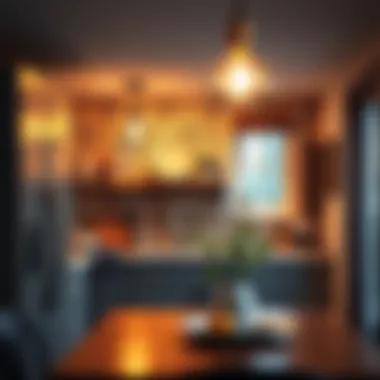

Selecting the right size pendant light leads to the next consideration—its placement in the kitchen. Having the right coverage transforms your cooking experience. Here are a few key points to keep in mind:
- Focus on Functionality: Locate pendants directly above work areas such as kitchen islands and countertops. Effective task lighting requires this precision—otherwise, you might find yourself chopping onions in shadows, which is neither safe nor pleasant.
- Spacing is Key: If you choose multiple pendants above a single area, space them evenly. A general guideline is to position them 24 to 30 inches apart to prevent hotspots and ensure uniform lighting.
- Visual Balance: When hanging multiple fixtures, ensure that they create symmetry and balance in the design rather than clutter. A haphazard arrangement can detract from the kitchen’s style, making it feel disorganized.
By giving thought to both size and positioning, you create not just a light source but a well-lit environment that elevates everyday tasks into enjoyable experiences. Remember, the goal is not just to illuminate but to illuminate wisely.
Placement Strategies for Effective Illumination
Effective placement of small kitchen pendant lights cannot be overstated. It establishes the overall lighting atmosphere while ensuring practicality in everyday tasks. The intersection of aesthetics and functionality in lighting design becomes clear when considering how pendant lights can guide movement, enhance style, and illuminate worksurfaces. Proper placement emphasizes the architectural design of a kitchen while catering to the unique activities performed within the space.
Above Islands and Bartops
Positioning pendant lights above kitchen islands and bar tops is a classic strategy that serves multiple purposes. These areas are typically hotspots for activity, whether it’s meal prep, casual dining, or social gatherings. By installing pendant lights at the right height—generally, about 30 to 36 inches above the surface—you can create a warm and inviting zone that draws attention and invites interaction.
Benefits include:
- Focused Task Lighting: This ensures that counters are well-lit, making cooking and cleaning easier and safer.
- Visual Interest: A well-placed pendant light can become a stunning focal point, enhancing the design of the kitchen.
- Height Variation: If the island has a different elevation or the bar top is at a higher level, adjust the height of the pendants to maintain balance and cohesion across the space.
The choice of pendant style also matters; a long, linear pendant works well above an island while a cluster of smaller pendants can create a dynamic line over a bar top, sparking interest and conversation.
In Open Spaces: Aesthetic Continuity
Open concept kitchens benefit greatly from strategically placed pendant lights. When connected to other areas, such as dining or living spaces, pendant lights can help define these separate areas while maintaining a continuous flow. A lighting scheme that respects this interconnectedness bolsters the aesthetic without overwhelming the visual senses.
Considerations for effective placement:
- Line of Sight: Ensure that pendant lights are visible from adjacent rooms or spaces; they should provide a visual link that draws the eye seamlessly across the open floor plan.
- Color and Style Matching: Select pendant lights that harmonize with the décor of adjacent spaces. Use shapes, colours, and materials that resonate with each other, making the whole area feel thought-out and intentional.
- Spacing: Maintain adequate distance between pendant lights and surrounding furniture to avoid a claustrophobic atmosphere. A general guide is to space pendants at least 2 feet apart, ensuring an even distribution of light and avoiding clutter.
Layering with Ambient and Task Lighting
A well-lit kitchen is about more than just pendant lights; it requires a thoughtful balance between ambient and task lighting as well. Layering these types of lighting can drastically enhance the workspace’s effectiveness as well as its ambiance. Pendant lights can act as task lighting when positioned correctly, but the right ambient lighting ensures the kitchen feels welcoming during gatherings or casual evenings.
How to layer effectively:
- Start with Ambient Lighting: Use ceiling-mounted fixtures or recessed lighting to provide a base level of brightness for the entire kitchen.
- Accent with Pendants: Introduce pendant lights to bring focus to key areas.
- Add Task Lighting: Introduce under-cabinet lights that complement pendant lighting without creating harsh contrasts.
- Dimmer Switches: Consider incorporating dimmer switches so the ambiance can shift effortlessly from busy kitchen use to relaxed evening dining.
Often, homeowners forget about the symbiotic relationship between these different light types. Each plays a crucial role, contributing to an experience that’s visually pleasing and functional. The proper placement strategy allows for seamless transitions between tasks, whether it's juggling meal prep or enjoying a nightcap after dinner.
Energy Efficiency and Bulb Options
In today’s world, where energy costs can stretch a budget, understanding how to choose the right bulb options for small kitchen pendant lights becomes paramount. Not only do these choices impact the overall lighting experience, but they also play a significant role in energy conservation and reducing electricity bills. An effective lighting strategy should prioritize energy efficiency without compromising brightness or aesthetic appeal. Let’s delve into some key elements that will help illuminate your path toward making informed choices.
Choosing LED for Longevity and Savings
When discussing energy-efficient lighting, LED bulbs simply cannot be overlooked. Their advantages are many.
- Long Lifespan: LEDs can last upwards of 25,000 hours, making them several times more durable than traditional incandescent bulbs.
- Energy Usage: These bulbs use up to 80% less energy compared to their incandescent counterparts while producing the same amount of light.
- Heat Generation: LEDs emit little heat compared to incandescent bulbs, making them safer and reducing cooling costs in warmer months.
Switching to LED not only provides savings on your energy bills, but also allows for a broad array of choices in color temperature, size, and brightness. For instance, if you prefer a warm, cozy ambiance in your kitchen, a soft white LED can achieve this while still being energy-efficient. In practical use, that can translate into less frequent replacements and more bang for your buck.
Color Temperature Considerations
Color temperature is another critical factor when it comes to selecting the right bulbs for your pendant lights. The temperature scale ranges from warm yellows to cool blues, typically measured in Kelvins (K). Here’s what to think about:
- Warm White (2700K - 3000K): This range creates an inviting atmosphere, perfect for cooking or entertaining. It mimics the soft glow of traditional incandescent bulbs.
- Neutral White (3500K - 4100K): Often ideal for task-oriented spaces, neutral white balances between warmth and daylight, offering clarity without being harsh.
- Cool White (5000K - 6500K): If you’re looking for bright, clear light that boosts efficiency, cool white is your go-to. It’s particularly good for detail-oriented tasks but might feel too stark for meal prep areas.
It’s essential to think about how these temperature options influence mood and functionality when choosing bulbs for your pendant fixtures. Have a think about how you want to feel in your kitchen, as it’s a place of creativity and nourishment after all.
"The right lighting can elevate your cooking experience while also being kinder to your wallet."
By combining energy-efficient bulb choices with thoughtful color temperature selections, you can create a perfectly illuminated kitchen space that complements both your lifestyle and your budget.
As you navigate these options, remember that investing in quality lighting is not just about aesthetics; it's also about fostering an environment that feels good, works well, and operates efficiently.
Maintenance and Care for Pendant Lights
Proper maintenance and care for pendant lights is crucial in ensuring their longevity and sustained aesthetic appeal. These fixtures are not just about function; they play a prominent role in the overall design of the kitchen. Given their central placement and frequent use, maintaining them not only enhances their appearance but also ensures safety and functionality. Regular care can prevent issues that might lead to costly replacements or repairs.
Taking the time to care for your kitchen pendant lights can keep them looking fresh and inviting. Dust and grime can accumulate, leading to flickering bulbs or even electrical problems, which pose safety hazards. Here is a breakdown of some essential care routines that can make a significant difference in the lifespan of these fixtures.
Cleaning Techniques for Different Materials

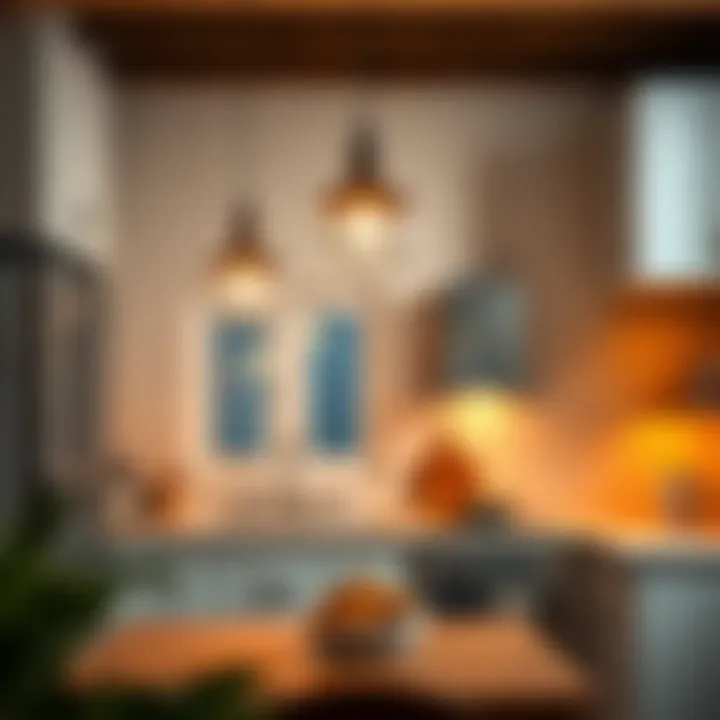
Cleaning methods will vary depending on the materials of the pendant lights. Each type requires a unique approach to avoid damage and maintain its shine.
- Glass Pendants: For these, a gentle soap solution and a soft microfiber cloth work wonders. Always avoid abrasive materials that can scratch the surface. A vinegar-water mixture may also be effective for tough spots, just be sure to dry thoroughly afterward to avoid streaks.
- Metal Fixtures: Stainless steel or brass pendant lights might need specialized cleaners to avoid tarnishing. For instance, a mixture of warm water and dish soap can be used for routine cleanings, but for deeper cleans, consider a metal polish specific to the type of metal. Always apply the polish with a soft cloth, avoiding brushes that could scratch.
- Natural Materials: If your pendant lights feature wood or rope, it's important to be gentle. A dry cloth should suffice for dusting. For deeper cleans, a damp cloth is fine, but excess moisture can degrade the material over time. Make sure to let them dry completely if they get wet during cleaning.
Regular Checks for Electrical Safety
Equally important is the need for routine checks on the electrical components of your pendant lights. This ensures not only optimal functionality but also safety in the kitchen environment.
- Inspect Wiring: It's essential to check the wires connected to the pendant lights at least once a year. Look for signs of wear, such as fraying or exposed wires. If you notice anything unusual, it's advisable to contact a licensed electrician.
- Check for Secure Mounting: Ensure the fixtures are securely mounted. A loose pendant might fall, causing injury. Gently tug on the fixture to check its stability. If it’s wobbly, tightening screws or bolts might be necessary.
- Bulb Checks: Regularly check and replace bulbs that flicker. Not only can they be a nuisance, but flickering could indicate underlying electrical issues. Use bulbs that are compatible with the fixture to ensure both performance and safety.
"Regular maintenance helps keep your pendant lights shining bright, and ensures that your kitchen stays safe and aesthetically pleasing."
Balancing Aesthetics and Practicality
When it comes to small kitchens, the challenge isn't just about having enough space or light. It's a delicate dance of bringing together aesthetics with practicality. Finding the right balance can significantly elevate the cooking experience while also ensuring that the space is functional and visually appealing.
Harmonizing with Kitchen Decor
The aesthetics of a kitchen can greatly influence how the space feels. Pendant lights come in a multitude of designs that can either blend in with your kitchen decor or stand out as a statement piece. When choosing lighting, consider how the pendant lights mirror or contrast the existing decor.
- Color Schemes: If your kitchen has a specific color theme, opt for pendant lights that either match or complement these hues. For example, if you have a predominantly earthy palette, brass or matte black fixtures may add a touch of elegance.
- Design Styles: If your kitchen leans towards a rustic vibe with wooden elements, a vintage or farmhouse-style pendant could tie the room together nicely. On the other hand, a sleek, modern pendant might work wonders in a minimalist kitchen.
Finding this harmony often requires a keen eye for detail. Think about how shapes, finishes, and even the height of the pendant can contribute to a cohesive look.
"A well-lit kitchen is like a well-set stage; it highlights the beauty of its actors while ensuring the performance goes smoothly."
Personal Style vs. Functional Requirements
Every homeowner has their own style, but practical needs often dictate certain choices. When selecting pendant lights, it's not just about selecting what looks good; it’s also about ensuring these fixtures meet your functional requirements.
- Task Lighting: In a kitchen, pendant lights often serve a practical purpose. For instance, if you enjoy cooking, select lights that hang lower and provide adequate illumination over work areas, like the counter and stove.
- Height Matters: The pendant's height can alter how functional they are. Too low and they might obstruct views; too high and they may not provide enough light. Make sure you measure appropriately based on your kitchen’s dimensions.
- Versatility: Some styles might seem appealing at first glance, but also consider how easily they can be adapted. Pendant lights that allow bulb changes to adjust brightness are ideal, catering to both mood and task lighting.
In summary, harmonizing personal style with functionality lays the groundwork for a successful kitchen design. Always prioritize what works best in the kitchen while ensuring it doesn’t compromise on the overall aesthetic you want to achieve.
Current Trends in Kitchen Lighting
In the world of kitchen design, lighting has become more than just a necessity—it's a vital piece of the decorative puzzle. Today, small kitchen pendant lights are at the forefront of this evolution, reflecting changes in technology, style, and environmental consciousness. Homeowners, designers, and DIY enthusiasts are increasingly gravitating toward options that harmonize practicality with sleek, modern aesthetics. Let's explore what the latest trends in kitchen lighting entail and how they enhance both functionality and visual appeal.
Smart Lighting Solutions
Gone are the days when lighting was merely an afterthought. Nowadays, smart lighting solutions have revolutionized how we think about illumination in kitchens. With innovations like voice-activated controls and mobile apps, homeowners can effortlessly adjust their lighting settings, creating the perfect ambiance at the touch of a button. Not only can you dim or brighten the lights, but you can also change color temperatures to match the time of day and mood.
Benefits of smart lighting include:
- Energy Efficiency: Smart bulbs often consume less power than traditional ones, helping you save on energy bills.
- Customization: Set schedules for when your lights should turn on/off or replicate sunrise and sunset effects for natural lighting.
- Integration: Connect your pendant lights to other smart home systems, such as security or entertainment.
Imagine cooking dinner in a warm, inviting glow and then switching to bright white light for a quick cleanup—all without lifting a finger! The adaptability makes small pendant lights not just stylish but incredibly functional as well, enhancing the kitchen experience.
"Smart lighting solutions don't just brighten your kitchen; they create a living space that adjusts to your lifestyle."
Sustainable and Eco-Friendly Options
As sustainability takes center stage, eco-friendly lighting alternatives are gaining traction. With the escalating awareness around environmental issues, homeowners are seeking pendant lights made from renewable resources or those that incorporate energy-efficient technology. Options such as pendant lights crafted from reclaimed wood or recycled glass are not only aesthetically pleasing but also minimalize ecological footprints.
Considerations for selecting eco-friendly lighting:
- Material Selection: Look for fixtures made from sustainable materials. For example, bamboo is a rapidly renewable resource.
- Energy-Efficient Bulbs: Integrate LED bulbs that last longer and use less energy compared to incandescent or halogen lights.
- Certifications: Seek products carrying energy certification labels that guarantee their eco-friendly claims.
As kitchen design evolves, choosing sustainable solutions reflects not just a personal ethic but also an awareness of global responsibility. When you choose eco-friendly pendant lights, you’re not just illuminating your kitchen; you’re making a statement about your values.
In summary, keeping up with current trends in kitchen lighting means embracing technology and sustainability. Smart solutions provide flexibility and convenience, while eco-friendly options ensure that beauty doesn’t come at the expense of our planet. Integrating these elements into small kitchen pendant lighting can create a harmonious balance of style and functionality.
Ending: Elevating the Kitchen Experience
As we wrap up our exploration of small kitchen pendant lights, it’s essential to recognize how pivotal this lighting choice is in the overall kitchen experience. These fixtures do more than just illuminate; they serve as focal points that can unite various styles within a small culinary space. The right pendant light can transform the ordinary into something extraordinary, enhancing both form and function.
Key Benefits of Small Kitchen Pendant Lights
- Spatial Dynamics: Pendant lights create visual interest, drawing the eye upward and making the ceiling feel higher, which is particularly beneficial in compact spaces.
- Versatile Styles: From chic modern to charming vintage, these lights cater to myriad aesthetic preferences, ensuring every homeowner can find a match for their taste.
- Task Efficiency: Properly placed pendant lights can aid in lighting specific work areas, such as the stove or the counter, making cooking safer and more enjoyable.
- Mood Setting: The ambiance of a kitchen greatly influences the cooking experience. The right pendant light can create a warm and inviting atmosphere for family gatherings or intimate dinners.
"Lighting isn’t just about illumination; it’s about creating an atmosphere where memories can be made and shared.”
Considerations for Homeowners
When integrating small kitchen pendant lights into your home, consider the following:
- Scale: Ensure that the size of the pendants complements the space without overwhelming it. A tiny light in a large area may get lost, while oversized pendants can dominate small kitchens.
- Height: Position these fixtures at an optimal height to cast light effectively without obstructing sightlines or space. Typically, suspending them 30-36 inches above surfaces works well.
- Dimming Options: Installing dimmers can offer flexibility and create the perfect mood for different activities, from casual breakfasts to formal dinners.
- Maintenance: Consider how easy or difficult it will be to clean and maintain the fixtures you choose. Some materials may show fingerprints or dust more easily than others.
At the crossroads of style and substance, small kitchen pendant lights offer a pathway to not only brighten up your cooking area but to elevate the entire kitchen experience. They reflect personal style while enhancing practicality, ultimately contributing to a more enjoyable home life. For many homeowners, these lights symbolize the heart of the home—a blend of function and design that continuously adapts to day-to-day activities. Whether you're embarking on a renovation, or simply looking to freshen your kitchen, investing in thoughtfully selected pendant lights can illuminate your culinary journey like never before.















